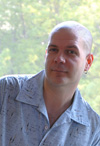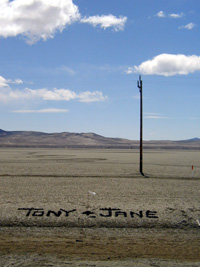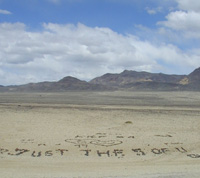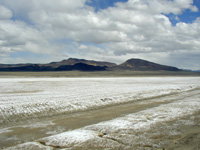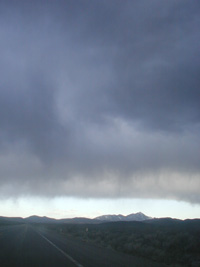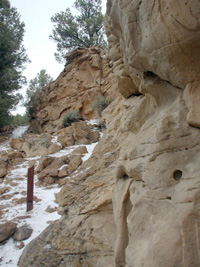On The Road:
|
Directory of all "On the Road" Articles> |
ON the ROAD with JAMES TEITELBAUM
Tiki Bar Expert & Author of Tiki Road Trip
|
Silence and Vandalism on the Loneliest Road in America by James Teitelbaum
|
Headed
east out of Reno on U.S. Route 50, James Teitelbaum
encounters a wasteland. Here, on the "Loneliest
Road in America," he ponders solitude, modern
rock art and nature's speed bumps. His venerable jalopy
barely survives the trip, and Teitelbaum counters
the strange attractions of the desert with a wild,
primordial scream..
|
Assuming (as you do) that one of your goals in life is to find a place where you can fill your lungs with clean, fresh air, steel yourself up, and shout at the sky as loud as you can and for as long as you are able, you may have more of a challenge ahead of you than you might think. There really aren't many places where you can do that. Best case scenario, people are going to look at you funny, or look at you with annoyance, or both. Worst case scenario, you're going to get rescued even if you aren't in trouble, and then you're going to have to explain to some cop or paramedic why you're shouting so loud, even though you aren't in trouble.
Still, howling at the sky is great for getting rid of tension. Remember that 1985 song by Tears for Fears? Remember how mellow those guys always seemed to be? They were hip to the therapeutic power of "Shout, shout, let it all out".
And so it came to pass that I found myself in my rickety old beater, leaving Reno, and headed home to Chicago. I was pondering whether to take the safe and fast -- if incredibly boring -- Interstate 80, or the much more intriguing alternate road: U.S. Route 50, a.k.a. "The Loneliest Road In America." Nevada's bits of U.S. Route 50 begin in Lake Tahoe, run through Carson City, and then veer north, so that the eastbound traveler from Reno can pick up the route at Fallon. There is literally no escape from the Loneliest Road after that point, at least not for a long time; you won't get to the next crossroads (where Route 50 crosses Routes 93 and 6 at Ely, Nevada) for almost 400 miles. The only towns along Route 50 east of Fallon are Austin, Eureka and then Ely.
|
Old U.S. Highways are always better routes to take on road trips than Interstates. Usually always, anyway. Besides, who can pass up an opportunity as enticing as finding out exactly how lonely the Loneliest Road in America is? I am so there. Four hundred miles, three towns, five mountain ranges, no other people, and a really crummy old car to make the trip in.
Genius.
We're on the Road to Nowhere
The sky was absolutely clear, the road was absolutely straight, and the temperature was rather mild for the Nevada desert. Good thing, too, because my air conditioner had long since given up. I think once it said to me: "Dude, you couldn't possibly be any cooler. There's nothing more I can do for you." And then it died.
Attaining cruising velocity, I found that U.S. Route 50 cuts across an absolutely flat Nevada, an expanse broken only by occasional strip of mountains (the Stillwater, Shoshone, Diamond, Toiyabe and Snake ranges, respectively), all of which run exactly perpendicular to the road. So you transverse some 60 miles of perfectly flat road, and then 25 miles of mountain terrain, and then repeat the pattern four times. The mountain ranges are like those annoying speed bumps popping up all over your neighborhood, but a little bigger. So you can go really freaking fast for 60 miles (if you're not in a rattletrap old Nissan that is shedding parts as you go). Then you get to climb mountains again for a minute, and then (yay!) you can go fast again.
I think that most people go fast, because this road lives up to its name. It is really, really lonely, and you might want to get back to civilization as soon as possible.
Or not.
Lonely is relative. Some people like the solitude; they
find beauty and joy in the fact that aside from the road
itself, there are many, many miles in which nothing man-made
can be seen. At all. No electrical poles stringing wires,
none of the fences that perpetually line every Interstate,
and not even a single example of the fascinating old rotting
barns that dot the landscape everywhere else you might drive.
There is nothing but desolate, salty, gravelly desert as
far as the eye can see in any direction, until you glimpse
one of the low and relatively unimpressive ridges of mountains
in the distance (unimpressive compared to the Rockies, Himalayas
or Andes, that is).
I wondered: How far can you go in this country without encountering any trace of humanity? How survivable is this landscape if the transportation fails? Why build this road at all?
Austin, Eureka and Ely: three small oases in the wasteland. They seemed like curiosities as I passed through them. Having grown accustomed to the solitude of this forlorn road, I found the presence of these tiny outposts of humanity to be almost disappointing. Having these quiet villages breaking up the dust and rocks every few hours made the tag "Loneliest Road in America" seem like an unfulfilled promise.
There is company to be found in Austin (population 340), Eureka (population 650) and Ely (population 4,041). I did wonder what kind of company it might be when I learned that the Eureka high school football team is called the Vandals. But the people of Austin are church-goers, with three houses of worship, the newest of which was built over 130 years ago. There is also a rocks and bottles museum. Nice combo.
Physical graffiti
Outside of this trio of near ghost towns, the only evidence of people along this desolate road is the very interesting public art they have left behind. I don't mean the native American petroglyphs to be found in the mountains (viewable at the Hickison Petroglyph Recreational Area, 28 miles east of Austin), though I do recommend that you see them. No, along the way, there is a much more contemporary art form to be discovered.
It seems that some enterprising road trippers have revitalized the idea of "rock art" and made it their own. For many miles there is a kind of graffiti in this desert, graffiti composed of rocks placed on the embankment next to the road, spelling out the names of those who took the time to pull the car over (surely no one was on foot), collect some geology, and memorialize their presence here for the foreseeable future.
Dark sand, light rocks, light
sand, dark rocks, either way the contrasts work. "Tyler."
"Doug." "O.P." "fuck off"
(this in little stones -- the artist apparently didn't have
the stones to write it larger). "ETKM." "Road
Trip" (love that one!). Lots of "So and So ![]() s
So and So." Mile after mile of this. Pick your interpretation:
modern-day paleo-art, environmental art, vandalism, disruption
of nature, kids blowing off steam, or simple reminders of
humanity on this lonely road. No advertising yet. Is it
only a matter of time?
s
So and So." Mile after mile of this. Pick your interpretation:
modern-day paleo-art, environmental art, vandalism, disruption
of nature, kids blowing off steam, or simple reminders of
humanity on this lonely road. No advertising yet. Is it
only a matter of time?
To end things as they began, you're no doubt waiting, with bated breath, to learn whether I paid my homage to Edvard Munch. It is all true. I was halfway between Eureka and Ely, a good 50 miles from either town, on the other side of the state from the rock art. I had passed no other cars the whole trip, and with nothing in sight to indicate the presence of civilization in any capacity (save for the lonely road itself), I pulled the car over, turned off the engine and -- to quote another 1980s pop band -- enjoyed the silence. I listened to nothing for a long, long time. No wind, no birds, no cars, no machinery, no electricity, no 1980s pop music. Just nothing.
If there had been a villain present, he'd have said: "Scream all you want! We're miles from where anyone can hear you!"
Yes sir, perhaps I'll take you up on that.
So then, just because I could, I took a deep breath, tilted my head up to the clear blue sky, and let loose. I felt a little bit silly, but also extremely liberated. I'd never been able to do this before, anywhere, at any time. The sound did not echo off the mountains; they were too far away. No one was there to question my madness. There weren't even any animals to disturb. I waited a moment and then did it again, and then a third time.
It felt good.
James Teitelbaum
11/23/07

